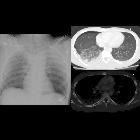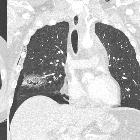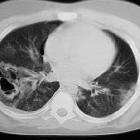lung contusions












A pulmonary contusion refers to an interstitial and/or alveolar lung injury without any frank laceration. It usually occurs secondary to non-penetrating trauma.
Epidemiology
While contusion can affect anyone, children are considered more susceptible due to greater pliability of the chest wall at a young age. In blunt chest trauma, the reported prevalence ranges around 17-70% .
Pathology
Contusions follow blunt or penetrating chest trauma, and are almost always seen with other chest (and abdominal) injuries. It is usually caused by disruption of the capillaries of the alveolar walls and septa, and leakage of blood into the alveolar spaces and interstitium .
Location
Features are often not localized in a lobar or segmental pattern. Contusions usually occur adjacent to bony structures (as fractures cause the contusions) and are hence seem to be peripherally located .
Radiographic features
Plain radiograph
An initial trauma chest radiograph may be normal. Over the first day following trauma, ill-defined geographic consolidation develop which are not sensitive for contusion, with differentials including aspiration, atelectasis, and infection.
Consolidation may be faint and usually shows rapid improvement with time, commonly over several days as the blood in the alveolar spaces is absorbed.
CT
Typically seen as focal, non-segmental (typically crescentic) areas of parenchymal opacification, usually peripheral. It can have subpleural sparing with smaller contusions which can be a distinguishing feature. More common posteriorly and in lower lobes.
Treatment and prognosis
In most cases, the findings are manifest at the time of the initial examination and show little tendency to increase in severity with subsequent examinations. Radiographic clearing of pulmonary contusion is relatively rapid, and the signs of contusion have often resolved within 48 hours. By day 10-14 they should have resolved completely .
If the consolidation increases a day or two after the traumatic injury, then superimposed aspiration, atelectasis and/or infection should be considered.
There is a significant risk of ventilator-associated pneumonia in a ventilated trauma patient who has pulmonary contusions, which carries high mortality (up to 50%) .
Differential diagnosis
General imaging differential considerations include:
- aspiration pneumonia
- segmental/focal atelectasis
- pulmonary hemorrhage
- pneumonia
- fat embolism
See also
Siehe auch:
und weiter:

 Assoziationen und Differentialdiagnosen zu Lungenkontusion:
Assoziationen und Differentialdiagnosen zu Lungenkontusion:


